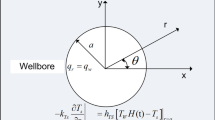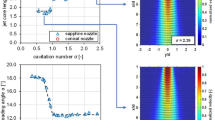Abstract
This study numerically investigates the dynamic behavior and heat transfer characteristics of electro-thermal drilling probes with five probe-tip shapes by analyzing the evolution of thin molten liquid layers. Commercial code ANSYS Fluent (v.20.2) was used to simulate the melting process with the dynamic mesh technique and estimate the probe velocity for different probe-tip shapes through energy conservation between the heating power and melting rate of surrounding ice. The results revealed that using the cone-shaped probe tip allowed the probe to move faster than the flat or round tip shapes because its molten liquid mass flow rate was higher than the rates of other tip shapes. Moreover, the fastest penetration was achieved using a 30° cone probe tip with the lowest heat flux because the liquid layer thickness and thermal resistance were the smallest.
Similar content being viewed by others
Abbreviations
- ρ :
-
Density [kg/m3]
- v :
-
Velocity of fluid [m/s]
- μ :
-
Dynamic viscosity [kg/m · s]
- τ :
-
Stress tensor [Pa]
- p :
-
Pressure [Pa]
- k :
-
Thermal conductivity [W/m · K]
- T :
-
Temperature [K]
- H :
-
Sum of enthalpy [J]
- c p :
-
Specific heat at constant pressure [J/kg · K]
- L :
-
Latent heat [J/kg]
- Q :
-
Heat transfer energy [J]
- T mp :
-
Temperature of melting point [K]
- T i :
-
Initial temperature of ice [K]
- T l :
-
Liquid temperature [K]
- δ :
-
Liquid layer thickness [m]
- A b :
-
Borehole area [m2]
- r b :
-
Borehole radius [m]
- v p :
-
Probe velocity [m/s]
References
B. C. Christner et al., A microbial ecosystem beneath the west antarctic ice sheet, Nature, 512 (7514) (2014) 310–313.
J. C. Priscu et al., Geomicrobiology of subglacial ice above lake vostok, Antarctica, Science, 286 (5447) (1999) 2141–2144.
P. H. Rampelotto, Resistance of microorganisms to extreme environmental conditions and its contribution to astrobiology, Sustainability, 2 (6) (2010) 1602–1623.
I. Alekhina et al., Code of conduct for the exploration and research of subglacial aquatic environments, XXXIV Antarctic Treaty Consultative Meeting, Buenos Aires, 20 (2011).
P. G. Talalay, Thermal Ice Drilling Technology, Springer (2019).
H. Motoyama, The second deep ice coring project at Dome Fuji, Antarctica, Scientific Drilling, 5 (2007) 41–43.
V. Zagorodnov et al., New technique for access-borehole drilling in shelf glaciers using lightweight drills, Journal of Glaciology, 60 (223) (2014) 935–944.
M. F. Horne, Thermal probe design for Europa sample acquisition, Acta Astronautica, 142 (2018) 29–36.
N. I. Kömle et al., Melting probes revisited-Ice penetration experiments under mars surface pressure conditions, Icarus, 308 (2018) 117–127.
R. Shreve, Theory of performance of isothermal solid-nose hotpoints boring in temperate ice, Journal of Glaciology, 4 (32) (1962) 151–160.
M. Treffer et al., Preliminary studies concerning subsurface probes for the exploration of icy planetary bodies, Planetary and Space Science, 54 (6) (2006) 621–634.
P. G. Talalay et al., Thermal tips for ice hot-point drilling: experiments and preliminary thermal modeling, Cold Regions Science and Technology, 160 (2019) 97–109.
Y. Suto et al., Laboratory experiments and thermal calculations for the development of a next-generation glacier-ice exploration system: Development of an electro-thermal drilling device, Polar Science, 2 (1) (2008) 15–26.
O. S. Erokhina and E. N. Chumachenko, A technique to simulate melting probe’s movement and to estimate penetration velocities’ range, 2015 International Conference on Mechanics-Seventh Polyakhov’s Reading, IEEE (2015) 1–4.
P. Weiss et al., Study of a thermal drill head for the exploration of subsurface planetary ice layers, Planetary and Space Science, 56 (9) (2008) 1280–1292.
U. J. Park et al., Numerical analysis of the close-contact heat transfer of the electro-thermal drilling probes for glacier-ice exploration, Journal of Mechanical Science and Technology, 35 (3) (2021) 1309–1317.
C. H. Jeong et al., Numerical investigation on the evolution of thin liquid layer and dynamic behavior of an electro-thermal drilling probe during close-contact heat transfer, Applied Sciences, 11 (8) (2021) 3443.
M. García-Díaz et al., CFD analysis of the performance of a double decker turbine for wave energy conversion, Energies, 14 (4) (2021) 949.
X. An et al., Numerical analysis of air vortex interaction with porous screen, Fluids, 6 (2) (2021) 70.
K. K. Agrawal et al., CFD simulation study to evaluate the economic feasibility of backfilling materials for ground-air heat exchanger system, Geothermics, 90 (2021) 102002.
A. Di Renzo et al., Coarse-grain dem modelling in fluidized bed simulation: A review, Processes, 9 (2) (2021) 279.
V. R. Voller, Modeling the unidirectional solidification of a binary alloy with the heat-balance integral method, Journal of Metals, 39 (10) (1987) A13–A13.
V. R. Voller and C. Prakash, A fixed grid numerical modelling methodology for convection-diffusion mushy region phase-change problems, International Journal of Heat and Mass Transfer, 30 (8) (1987) 1709–1719.
V. R. Voller et al., The modelling of heat, mass and solute transport in solidification systems, International Journal of Heat and Mass Transfer, 32 (9) (1989) 1719–1731.
V. R. Voller and C. Swaminathan, ERAL source-based method for solidification phase change, Numerical Heat Transfer, Part B Fundamentals, 19 (2) (1991) 175–189.
K. G. Kang and H. S. Ryou, Computation of solidification and melting using the PISO algorithm, Numerical Heat Transfer, Part B: Fundamentals, 46 (2) (2004) 179–194.
J. Lu et al., Solidification and melting behaviors and characteristics of molten salt in cold filling pipe, International Journal of Heat and Mass Transfer, 53 (9–10) (2010) 1628–1635.
M. M. Al-Maghalseh, Investigate the natural convection heat transfer in a PCM thermal storage system using ansys/fluent, Jordan Journal of Mechanical and Industrial Engineering, 11 (4) (2017).
P. G. Talalay et al., Recoverable autonomous sonde (RECAS) for environmental exploration of antarctic subglacial lakes: general concept, Annals of Glaciology, 55 (65) (2014) 23–30.
I. A. Zotikov and R. Hardin, The Thermophysics of Glaciers, Springer (1986).
Acknowledgments
This research was supported by a grant from the endowment project of “Development of core technologies of underwater robot ICT for polar under-ice-shelf exploration and remote monitoring” funded by the Korea Research Institute of Ships and Ocean Engineering (PES4390). Also, this research was supported by the Chung-Ang University Graduate Research Scholarship in 2021.
Author information
Authors and Affiliations
Corresponding author
Additional information
Seung Ho Yeom received his B.S. degree from Chung-Ang University. He is currently M.S. candidate in School of Mechanical Engineering at the Chung-Ang University. His research interests are heat transfer and computational fluid dynamics.
Kwangu Kang received his B.S., M.S., and Ph.D. in Mechanical Engineering Department from Chung-Ang University in Korea. Now, he is a Principal Engineer in Korea Research Institute of Ships & Ocean engineering (KRISO). His research interests are cryobot, reliability evaluation, and risk management in offshore plant.
Jin-Yeong Park received his Ph.D. degree in mechanical engineering from Korea Advanced Institute of Science and Technology (KAIST), Republic of Korea, in 2011. He joined the Ocean System Engineering Research Division of Korea Research Institute of Ships & Ocean engineering (KRISO) in 2008 as a Research Scientist. His research interests are ultrasound imaging processing, control and design for underwater unmanned vehicles.
Seong Hyuk Lee received his B.S., M.S., and Ph.D. in Mechanical Engineering Department from Chung-Ang University in Korea. Now, he is a Professor of Mechanical Engineering Department at Chung-Ang University. He has various research fields in heat and mass transfer: Interfacial phenomena, evaporation/con-densation heat transfer, SPR visualization, and computational physics.
Rights and permissions
About this article
Cite this article
Yeom, S.H., Kang, K., Park, JY. et al. Influence of electro-thermal probe tip shape on thin liquid layer evolution and penetration speed in glaciers. J Mech Sci Technol 37, 527–535 (2023). https://doi.org/10.1007/s12206-022-1249-5
Received:
Revised:
Accepted:
Published:
Issue Date:
DOI: https://doi.org/10.1007/s12206-022-1249-5




